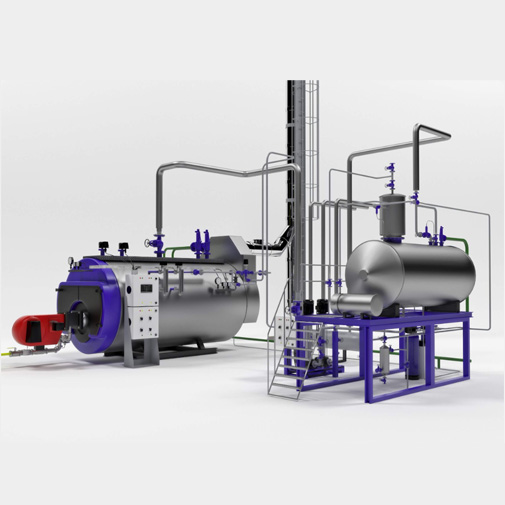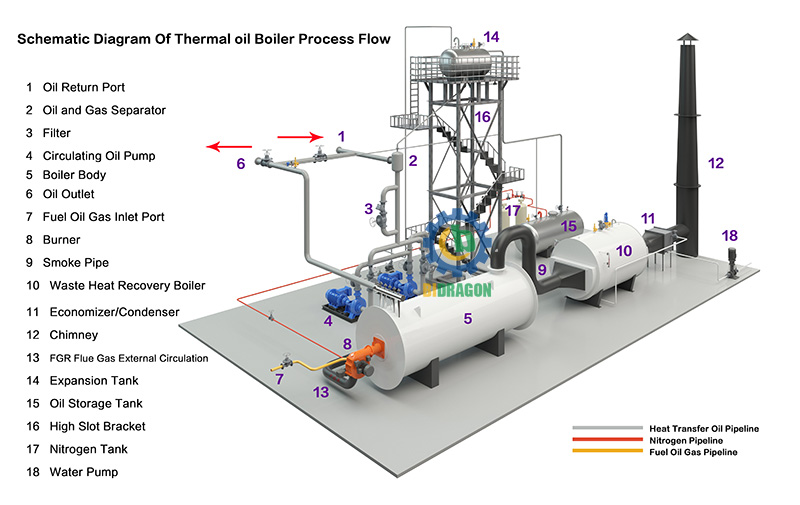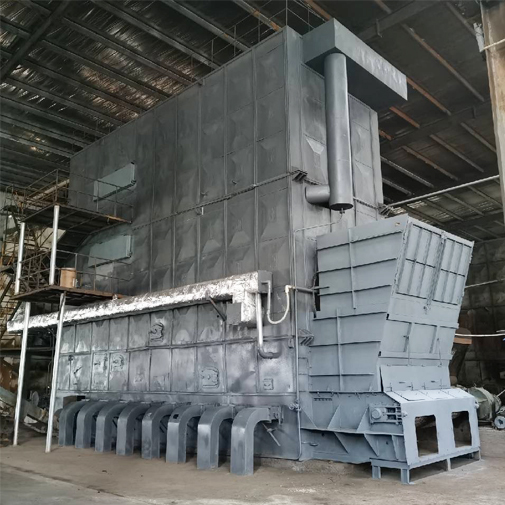In the global industrial pattern, the textile industry occupies an extremely important position. It is not only a typical representative of labor-intensive industries, but also a key force in promoting economic development. From the production of fibers, to the spinning of yarn, and then to the fabric weaving and dyeing, the textile industry every link is inseparable from the support of energy. In many energy equipment, boilers play a pivotal role in providing indispensable heat and steam for the textile production process.
Boilers are Used in Various Stages of Textile Manufacturing

Pretreatment Stage
Pretreatment is the most critical starting point in the textile process. Its core task is to remove the raw materials or fabrics on the dirt and impurities, these substances are not removed, it is very likely that in the subsequent processing of the damage to the quality of the fabric. Whether it is the removal of impurities from cotton fibers or the surface treatment of chemical fibers, efficient cleaning and treatment processes are required. High-quality steam and hot water play a key role in this process. For example, in the boiling process of cotton fabrics, high-temperature and high-pressure steam can quickly and effectively remove pectin, wax and other natural impurities on cotton fibers, laying a good foundation for the subsequent dyeing and finishing process. Therefore, a steam boiler with excellent performance is the necessary equipment for the pretreatment stage.
Sizing
Sizing is an important part of the weaving preparation process. It is not only a test and consolidation of the quality of the previous process, but also directly related to the smooth progress of the subsequent weaving. High-quality sizing can effectively reduce the brittle breakage rate of yarn in the weaving process, improve the attachment rate of sizing, and ensure that the dampness rate of yarn is in the appropriate range, thus significantly improving the weaving efficiency. In the case of common cotton fabrics, for example, a suitable sizing process can increase weaving efficiency by 10% - 20%. This can only be achieved with the support of high-quality steam boilers. A steady supply of steam enables precise control of the temperature in the sizing bath, ensures the uniformity and fluidity of the sizing liquor, and improves the quality of the sizing yarn.
Bleaching Process
Depending on the type of fabric and the requirements of the end product, there are various methods of bleaching. Among the many methods, steam bleaching is one of the most widely used technologies in the textile industry due to its high efficiency and environmentally friendly characteristics. Different materials of fabrics, such as cotton, hemp, silk, chemical fiber, etc., the bleaching temperature, humidity and time requirements are different. The boiler can be based on these specific needs, the precise regulation of steam parameters, for all types of fabrics to provide the most appropriate bleaching environment. For example, for the more sensitive to the temperature of the silk fabric, the boiler can provide a mild and stable steam conditions, in order to achieve effective bleaching at the same time, to maximize the protection of the soft feel of silk and bright luster.
Dyeing
Dyeing is a key step in giving textiles color and personality. Whether it is natural fibers, such as cotton, linen, silk, wool, or chemical fibers, such as nylon, polyester, etc., can be dyed through the dyeing process to bring out the unique charm. From a technical point of view, dyeing can take place at any stage of textile fiber, yarn production or fabric processing. And the process of dye transfer to the fabric is highly dependent on the precise temperature and humidity conditions provided by steam. Steam boilers heat water and convert it to steam at a specific temperature, ensuring that the dye bath reaches the optimum dyeing temperature. For example, in reactive dyestuff dyeing, precise control of the bath temperature between 60 - 90 degrees Celsius allows the dyestuffs to react with the fibers, resulting in vibrant colors and high color fastness.
Finishing (drying) stage
The finishing process of textile processing is complex and delicate, covering a number of key steps, of which the wrinkle removal treatment of the fabric is particularly important. For some fabrics, it is difficult to achieve ideal results with traditional dry heat ironing or ordinary ironing, while steam wrinkle removal shows unique advantages. Through the steam boiler to produce high-temperature steam, can quickly penetrate the fabric fibers, so that its molecular structure changes, thus effectively eliminating wrinkles, to restore the fabric's flat and straight. At the same time, the humidity of the steam can also protect the fabric fibers to a certain extent, to avoid damage caused by excessive drying.
Types of Boilers Commonly Used in the Textile Industry
Steam Boilers

In the textile industry, steam boilers play an irreplaceable role in heating dye baths. After the textile material is immersed in a dye bath containing water and dye, the steam boiler quickly heats the bath to the proper dyeing temperature. Typically, steam boilers produce steam at temperatures ranging from 100°C to 450°C, which meets the stringent temperature requirements of different dyestuffs and fabrics. In terms of fuel selection, the steam boiler has a wide range of adaptability and can use a variety of energy sources such as diesel, liquefied petroleum gas (LPG), heavy oil, electricity, coal, woody biomass, rice husk, bagasse, sawdust, palm fiber and so on. This diversity of fuel options allows textile companies to make flexible decisions based on local energy supply conditions and cost effectiveness. In addition, steam boilers are widely used in many industries such as food, beverage, milk processing, feed mills, garments, plywood, paper mills, chemicals, laundries, rice mills, refineries, etc., which fully demonstrates their versatility and importance.
Thermal Oil Boiler

The working principle of thermal oil boiler is to heat the thermal oil to a high temperature state, and then through the circulatory system, the hot oil will be transported to the heat exchanger or directly to the dyeing equipment. In this process, the thermal oil transfers heat to the dye bath or dyeing machinery, realizing efficient heat transfer. The thermal oil boiler is capable of heating the thermal oil to different temperature levels such as 200°C, 250°C, 300°C, 350°C, etc., which can meet the demand for high temperature heat source in the textile production process. In terms of structural design, thermal oil boiler mainly has three types: vertical, horizontal and stainless steel. Vertical structure covers a small area, suitable for textile enterprises with limited space; horizontal structure has better stability and larger heat capacity; stainless steel has excellent corrosion resistance, suitable for health and corrosion resistance requirements of high production environment. In addition to the textile industry, thermal oil boiler is also widely used in asphalt, plywood, plastics, food and other industries.
Industrial Biomass Boiler

With the increasing global concern for environmental protection and sustainable development, industrial biomass boilers are increasingly used in the textile industry. Compared with traditional fossil fuel boilers, industrial biomass boilers have significant advantages. First, in terms of fuel consumption, it can utilize a variety of biomass fuels, including various types of wood, wood chips, bark, sawdust and straw. These biomass fuels are from a wide range of sources and relatively low cost, which can effectively reduce energy procurement costs for textile enterprises. Secondly, from the perspective of environmental benefits, biomass fuels are renewable energy, in the combustion process of greenhouse gas emissions are much lower than traditional fossil fuels, to help textile companies to reduce the carbon footprint, and actively respond to the requirements of environmental regulations. In addition, industrial biomass boilers operate stably and reliably, capable of running continuously for long periods of time without frequent downtime for maintenance, ensuring the continuity and stability of textile production. This not only improves productivity, but also reduces the risk of production interruptions due to equipment failure, bringing long-term economic benefits to the company.
Thermal Oil Boiler in the Textile Industry Favored Reasons
Technical advantages
thermal oil boiler with high-temperature thermal oil as the heat transfer medium, its operating temperature up to 350 ° C, this temperature far exceeds the saturated steam temperature of the steam boiler. In the textile printing and dyeing process, many parts of the high-temperature heat source has a rigid demand, such as heat-setting, hot-melt dyeing and other processes. The high temperature characteristics of thermal oil boiler can accurately meet these process requirements to ensure the quality and performance of textiles. For example, in the heat-setting process, a stable high-temperature environment can make the fabric fibers quickly set, giving the fabric good dimensional stability and appearance of flatness.
Fit for textile production
Textile production equipment, such as heat-setting machines, dryers, etc., need a constant and stable high-temperature heat source to ensure the continuity of the production process. Heat conduction oil furnace has excellent constant temperature characteristics, can effectively avoid product quality problems caused by temperature fluctuations, reduce the rate of defective products. Take the heat setting machine as an example, a stable high temperature environment can make the fabric uniformly heated under the set temperature to ensure that the molecular structure of the fiber is fully adjusted to achieve the desired shaping effect. If the temperature fluctuates, it may lead to insufficient or excessive localized shaping of the fabric, affecting product quality and appearance.
Economic and environmental benefits
Although the initial investment of the heat transfer oil furnace is relatively high compared to the steam boiler, it has a significant advantage in terms of operating costs. The high thermal efficiency of the heat conduction oil furnace can effectively reduce energy consumption, for textile enterprises to save a lot of energy costs. To a medium-sized textile enterprises, for example, the use of thermal oil boiler, the annual energy costs can be reduced by 15% - 20%. In terms of environmental performance, heat transfer oil furnace emissions compared to steam boilers reduced by more than 30%, and do not need to deal with complex boiler drainage problems, greatly reducing the pressure on the environmental protection of enterprises.
How To Choose The Right Boiler For The Textile Industry
Determining Boiler Capacity
Accurately determining boiler capacity is the key to ensuring efficient operation of textile production. In practice, boiler capacity is usually determined on the basis of heating load curves or heat balance diagrams. This not only takes into account the actual heat consumption during the production process, but also includes piping heat loss, self-used heat in the boiler room and available waste heat. However, in practice, obtaining a heating load curve is not easy. In this case, it can be estimated based on the maximum hourly heat consumption in production, heating or living, combined with the corresponding coefficients. For example, for a textile factory that mainly produces cotton fabrics, the maximum hourly heat consumption can be roughly estimated by counting the power and running time of the equipment for dyeing, drying and other processes, and then multiplied by the appropriate coefficients (generally 1.1 - 1.3), the boiler's capacity can be initially determined range.
Selected heating supply medium
In the textile industry, steam boilers have become the preferred heating supply medium in the production process because of their ability to provide high temperature and high pressure steam. For example, in the dyeing, finishing and other processes, steam can quickly transfer heat to meet the process of the strict requirements of temperature and humidity. However, if the enterprise in the production process at the same time there is a large number of hot water demand, such as staff living hot water, part of the pre-treatment process on the demand for hot water, etc., it is necessary to consider the configuration of steam boilers and hot water boilers, in order to achieve a reasonable use of energy and the balance of supply.
Clarify boiler heating parameters
The heating parameters of the boiler, such as pressure and temperature, are directly related to the quality and efficiency of textile production. Different textile processes have specific requirements for the pressure and temperature of steam or heat transfer oil. For example, in high temperature and high pressure dyeing processes, a steam boiler is required to be able to provide a steam pressure of 1.0 - 1.5MPa and a temperature control of 130 - 150°C to ensure that the dyes are able to fully penetrate the fibers and achieve uniform dyeing. Therefore, when selecting a boiler, the heating parameters of the boiler must be accurately determined according to the specific needs of the textile process to ensure that it can meet the production requirements.
Consideration of boiler efficiency
In order to achieve economic management, it is crucial to select a boiler with high thermal efficiency. Efficient boilers can provide sufficient heat and reduce the operating costs of the enterprise while consuming less energy. At the same time, the output power, quantity and other performance indicators of the boiler should have good flexibility and be able to be automatically adjusted according to changes in the heat load during textile production. For example, in the off-season or partial shutdown of the equipment, the boiler can automatically reduce the output power to avoid energy waste; and in the peak season or when the equipment is running at full capacity, it can quickly increase the output power to meet the production demand.
Careful selection of boiler models
When choosing a boiler model, it is recommended to prioritize boilers with the same capacity or the same combustion equipment. This helps to simplify the installation layout and daily management and maintenance of the equipment. If different boiler models must be selected due to production requirements, under normal circumstances, the model difference should not exceed two. Too many model differences will increase the complexity of equipment management, such as inventory management of spare parts more difficult, increased operator training costs. For example, a textile company in the expansion of production lines, in order to work with the original steam boiler, the same brand, the same series but slightly larger capacity boiler, which not only ensures the production requirements, but also facilitates equipment management and maintenance.
Conclusion
In summary, the textile industry's demand for boilers permeates the entire production process. From pretreatment to finishing, every step relies on suitable boilers for thermal support. Steam boilers, heat transfer oil furnaces, and industrial biomass boilers each have distinct roles in the textile industry, with varying performance features, application scenarios, and environmental advantages. Among them, the heat transfer oil furnace, due to its technical superiority, precise alignment with textile production needs, and remarkable economic and environmental benefits, has gradually emerged as the mainstream choice in the textile sector.
When choosing a boiler, textile enterprises must take into account factors such as boiler capacity, heating supply medium, heating parameters, efficiency, and models. This ensures that the selected boiler can meet production requirements and achieve high - efficiency, energy - saving, and environmentally - friendly production goals. Looking ahead, with the continuous advancement of science and technology, boiler technology in the textile industry is anticipated to witness more innovations and breakthroughs, further propelling the textile industry towards a green and sustainable future.

























